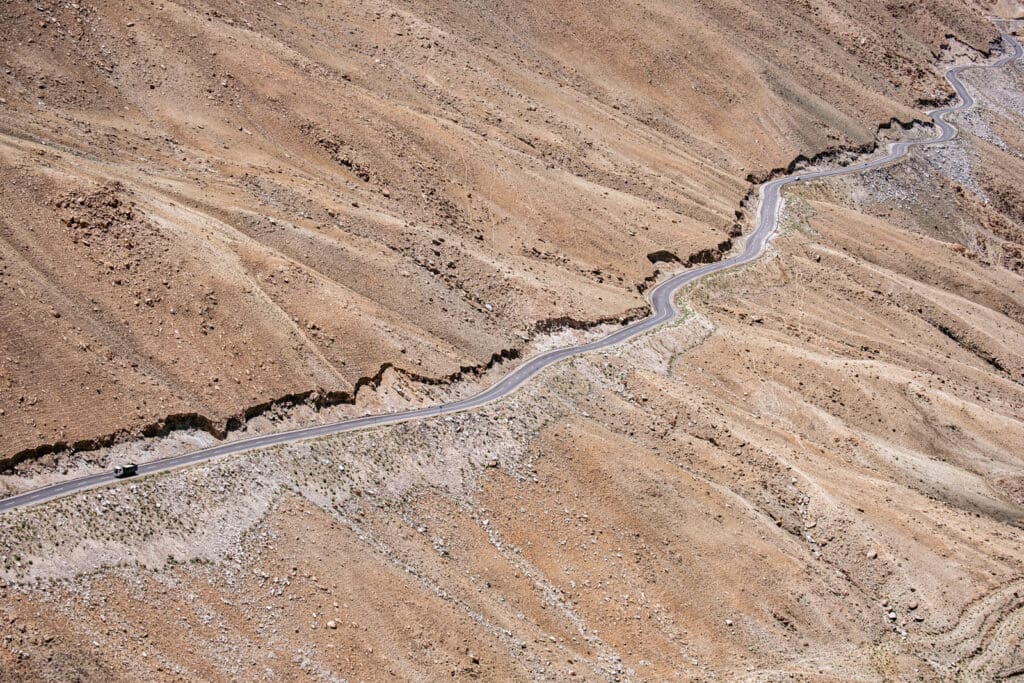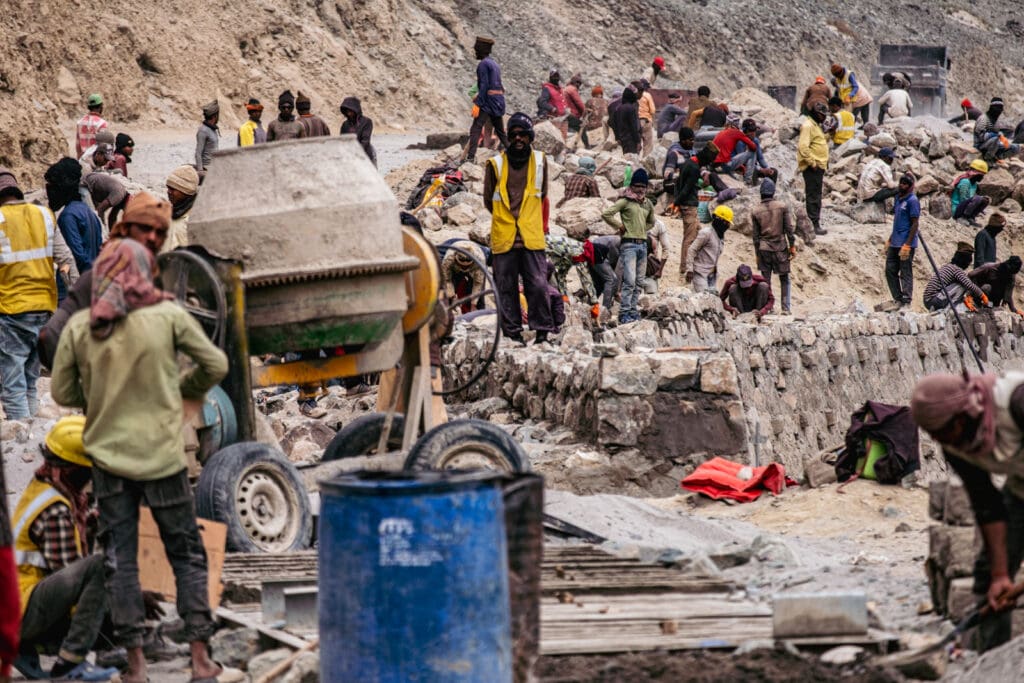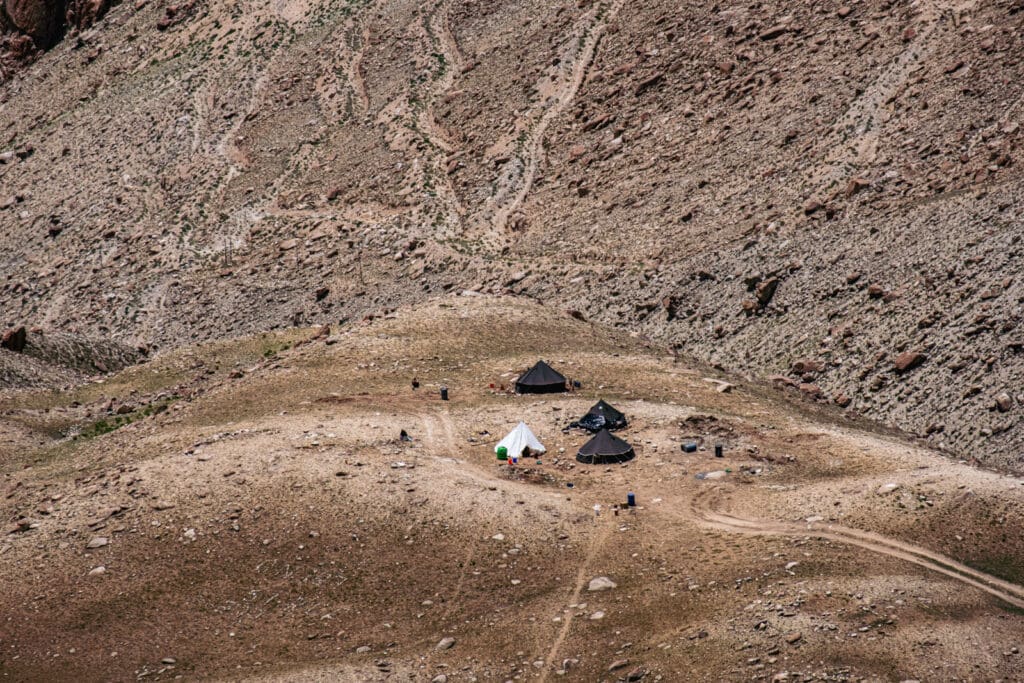Borrowing—just for a moment—the name of a well-known technical motorcycling column, “Piega e Spiega”, I’d like to take you into a world, or rather a region, that is geographically enclosed by peaks rising above 7,000 metres, and tell you—or better, explain to you—the story of its roads.

A Border Region
Let’s start by placing this region on the map of India and trying to understand its main features.
Ladakh lies in the north-east of the country, wedged between China and Pakistan, in a unique and complex geographical position. Its elevation ranges from 2,700 metres to well over 7,000, with a landscape that is mostly rocky and sandy, broken only by a few green oases along the main rivers and by vast glaciers.
Anyone travelling its roads quickly notices, beyond the spectacular scenery, the strong military presence—the defining feature of this region. You come across bases, logistics outposts, and long convoys of military vehicles moving in line for dozens of kilometres. Some bases support air operations, others armoured units or assault teams. Many military structures remain hidden: tanks and anti-aircraft systems are well concealed among the mountains, yet it is clear that Ladakh is strategically important to India.
In 2020, in the Galwan Valley, the most recent episode highlighting this fragile geography occurred: a hand-to-hand clash between Indian and Chinese soldiers, without firearms. A brief but violent encounter that caused casualties on both sides and served as a reminder of how undefined and delicate this border still is.
Today, however, despite the heavy military presence, there is no sense of tension.
Life goes on as usual, and the military coexist with the local population along all the main and minor roads of this harsh region.

Who Builds the Roads of Ladakh
Behind the black strip of asphalt that cuts through mountains of sand and ice stands the Border Roads Organisation, known simply as BRO. It is a government agency founded in 1960 to ensure safe military communications in border areas. Over time, its role has expanded into the civil sphere as well, building and maintaining most of the roads that cross the Indian Himalayas, including those in Ladakh.
Today, the BRO is everywhere: in the valleys, at the foot of the passes, in villages, and in the gorges where the air grows thinner. Its green signs have become part of the landscape, alongside bulldozers, lorries, and teams of workers who, day after day, keep the world’s highest road network alive.
Field Work
Most of the roads in Ladakh were built by the BRO (Border Roads Organisation) in conditions that, at first glance, would seem impossible. Work is often carried out between 4,000 and 5,800 metres, where even breathing becomes a conscious effort. Operating at such altitudes requires specific preparation: those arriving from lower regions of India must spend several days acclimatising before taking on full shifts. At those heights, the body burns more energy, and sustaining prolonged physical effort can become dangerous.
It is striking to see how many people are involved in a single stretch of road: at times dozens of workers operate on segments barely fifty metres long. Some dig, others level the ground or move stones, while others simply wait for their turn. It is not inactivity — it is a rotation system designed to avoid excessive strain and to maintain a steady pace. You may see them wash their hands or faces with rainwater collected in empty bitumen barrels, between one break and the next, before returning to work.
Manual labour remains central—laying stones, building retaining walls, reinforcing embankments—and machinery is used only where terrain permits.
Many workers live in temporary tents set up along the roadside, with improvised kitchens and diesel stoves. On larger worksites, temporary villages emerge, with larger tents, shared areas, and spaces where families can spend months on site. Often, these works are in extremely remote areas, far from Leh or any significant settlement, and workers may stay for weeks or even months, both because of the complexity of the projects and the need to keep teams ready to intervene in emergencies. Wherever possible, military personnel and part of the civilian workforce are housed in army camps, which also serve as logistical bases. Many workers are themselves part of the military environment or work closely with it.
Along the routes, one also encounters mobile asphalt production units.
The BRO receives liquid bitumen from other regions of India and processes it on site to prepare the asphalt mix needed for road surfacing. This system allows them to work independently, reducing the need to transport to more equipped areas and speeding up repairs in the event of landslides or damage. It is a practical solution, born from the direct experience of those who know well the challenges of working at these altitudes.

A Climate That Doesn’t Forgive
The climate in Ladakh is among the harshest on the planet. Temperatures can range from 30 degrees in summer to –50 degrees in winter. The wind blows constantly, lifting sand and gravel and making it difficult to work outdoors for long hours. Even the machinery suffers: engines struggle to start, asphalt cracks under temperature swings, and ice works its way into everything.
During the monsoon season, landslides are frequent and entire sections of road are swept away. As soon as conditions improve, the BRO returns to work to make everything safe again. For this reason, it is common to find open worksites or blocked sections undergoing repairs.
At times, after an exceptionally severe winter, roads are completely dug up and rebuilt from scratch. In summer, however, the problem is the opposite: the heat accelerates glacier melt. In the morning, streams remain contained, but in the afternoon, rising temperatures increase their volume dramatically, creating torrents that cut across the road. In the most extreme cases, the water erodes the mountainside, carrying stones and sand downhill and depositing them onto the streets, cutting them off.
It is a continuous cycle: each winter destroys, and each summer rebuilds.
Despite everything, in just a few years, the BRO has paved around 80% of Ladakh’s road network, improving accessibility and reducing travel times. It also holds the record for the world’s highest paved motorable pass, at 5,799 metres above sea level. A figure that, more than any words, conveys the scale of their work.
It is worth remembering that all of this exists primarily for logistical and military purposes. The roads of Ladakh are not merely infrastructure: they are human, economic, and strategic lifelines. Every kilometre of asphalt allows food, fuel, medicine, and materials to be transported—supplies that would otherwise never reach these areas. And behind it all are hundreds of people who face the cold, the altitude, and the distance from home, often for months at a time.
The BRO has continued to operate with the same approach for more than sixty years: method, adaptation, and constant presence. The result is a territory which, despite being one of the most challenging in the world, remains connected and accessible.
A fragile yet tangible balance, made of roads, hands, and determination.

Safety with a Touch of Irony
I want to end with a touch of irony—the same one you find along the roads of Ladakh.
One of the things that most strikes travellers here is the BRO’s green road-safety signs. They are everywhere, and they often make you smile: short phrases in English, written in rhyme or with playful word twists, reminding you to drive carefully.
Simple, direct, and witty, these signs have become part of the landscape and of the Himalayan road culture.

